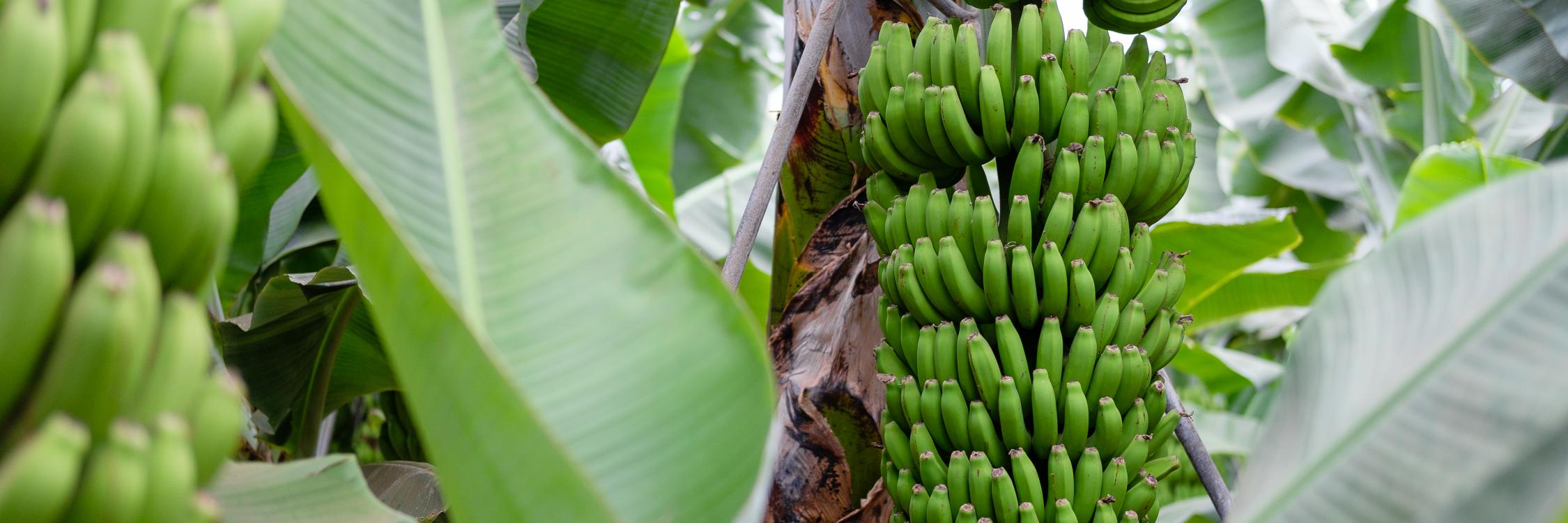
What you need to know about growing bananas
A balanced fertilization for bananas
The banana is the main tropical fruit exported throughout the world and it is mainly produced in large plantations. A balanced fertilization is a guarantee of a quality and marketable fruit production.
Mineral nutrition
Bananas prefer deep soils, a good drainage, and a pH from 5.5 to 6.5, although bananas are cropped on a wide range of soils. A standard field production (50 to 60 MT. ha-1) requires 500-600 kg N. ha-1, 200 kg P2O5.ha-1 and 1,300-1,500 kg K2O.ha-1. Phosphorus is applied at planting and later broadcast in ratoon crops. Nitrogen and potassium are applied in split applications, along the cropping period. Fertigation is the best application method to match the demand of the plant.
Potassium in banana cropping
The banana has the highest requirement for potassium out of all crops. Potassium plays an essential role in terms of both high yields and fruit quality. It stimulates early shooting and significantly shortens the time required for fruit maturity. It improves both bunch grade and the size of fingers. The deficiency symptoms include an orange yellow color of old leaves, scorching along the margins, a reduction in total leaf area, as well as curving of midribs etc. Choking of the leaves delays flower initiation and leads to a reduction in yield and quality. Bananas are badly shaped, poorly filled and unsuitable for marketing.
Potassium sulfate for high grade production
The banana is a chloride-sensitive crop and chloride affects both yield and fruit flavor. A high concentration of chloride disturbs water exchanges and reduces element uptakes from the soil. The risk is enhanced in cases of saline irrigation water or poorly drained soils.
Several experiments comparing potassium sulfate and potassium chlorine treatments at the same dose of potassium illustrate the detrimental effect of chloride. An increase of 10 - 20% in total production is frequently observed with SOP over MOP treatment. NOP favors vegetative growth and reduces fruit production. Finally, SOP is the best choice as presented below in this example from India. SOP also allows an earlier maturity and better flavor thanks to a higher sugar content.
Potassium sulfate for quality
Potassium sulfate also has a positive effect on quality parameters. An illustration is given below from an experiment in India that compares SOP and MOP application at 330 g per tree, on total soluble sugar and on the sugar/acidity ratio, as well as on production parameters.
SoluPotasse® use in banana production
As is the case for many plants that grow quickly, banana crops benefit from fertigation. SoluPotasse , the soluble grade of potassium sulfate, contributes to high quality production and a better water and fertilizer use efficiency with an NPK ratio adapted to each stage of the banana's growth. SoluPotasse can be used in fertigation, enabling growers to separately apply nitrogen and potassium. Below is an example of a fertigation program for a standard banana production.
Benefits of foliar potash application with K-Leaf®
As is the case for many plants that grow quickly, bananas benefit from foliar applications. K-Leaf contributes to high quality production and an enhanced efficiency of basal dressing. Foliar applications of K-Leaf® improve yield, sugar content and the shelf life of fruits which show an earlier maturity. In the experiment below, two foliar sprays at 0.5, 1 and 1.5% concentration were applied at the opening of last hand and 30 days later. The 1.5% treatment shows a yield increase by 25%, which is mainly due to more fingers and higher finger weight, as shown below. Foliar applications of K-Leaf also induce early maturity and improve shelf life.
The importance of sulfur
Sulfur is the main component of amino acids and vegetal proteins. It performs the role of enzymatic activator and participates in chlorophyll synthesis. 0.23% of S in the banana leaf is the critical concentration. Deficiency symptoms include a generalized yellowing of the foliage, and new leaves will show light colors. This is consistent with the fact that S in not a mobile element within the plant. Deficiency symptoms should be most apparent on the youngest foliage. Plants that are severely deficient in sulfur will develop necrotic leaf margins along with a slight thickening of the veins. There can also be a frequent deficiency of certain micronutrients such as zinc and boron.